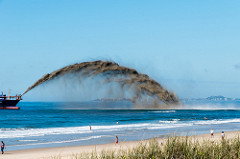When you think of air pollution, you might think of smog or automobile emissions, but think again. Scientists at the Cooperative Institute for Research in Environmental Science at the University of Colorado, Boulder and NOAA have recently published in Science in February 2018 detailing their findings that petroleum-based chemicals used in items like perfumes, soaps, deodorants, and paints emit as much volatile organic compounds (VOC) as motor vehicles. VOCs interact with particles in the air that then develop into smog primarily in the form of ozone, which can trigger asthma as well as scar lung tissue. They can also develop into a type of pollution called PM2.5 that has been linked to heart attacks, strokes, and lung cancer.

After regulations were developed in the 1970s to limit VOC emissions from automobiles, commodities like pesticides and personal care products became increasing cause of air pollution. The stricter regulations on car emissions made it more obvious than ever to scientists that household and personal products were a bigger threat to air quality. The study was influenced from past measurements collected of VOCs in California, which had shown higher concentrations of petroleum-based compounds at higher levels than initially predicted from fossil fuel sources alone.
Researchers realized that even though drivers use far more fuel (by weight) than they do personal or household products, gasoline is “stored in an airtight tank, it’s burned for energy, and converted mostly to carbon dioxide,” said Jessica B. Gilman, who was involved in the study. Since carbon dioxide emissions are not smog-forming VOCs, it does not contribute to air pollution as much as a spray or squirt of a petroleum-based product, most of which ends up in the atmosphere.
For their calculations, the authors of the study created a computer model that simulated air quality in Los Angeles by using data from the chemical composition of tailpipe emissions consumer goods. Based off these calculations, they found that roughly half of the VOCs in the air could be attributed to consumer products.
These findings have huge implications for human health, especially because most consumer products are used indoors. The traditional approaches to mitigate air pollution are not enough because they commonly focus on transportation or industrial sources. The regulations need to be extended to consumer products as well to mitigate their effects on environmental and human health. If you want to do more to decrease your impact on air pollution, “natural” products aren’t necessarily the answer, as many chemicals used in these products are incredibly reactive and well still form VOCs. The best option is to use as little household product as you can when you need to.
McDonald, B. b., de Gouw, J. A., Gilman, J. B., Jathar, S. H., Akherati, A., Cappa, C. D., & … Trainer, M. (2018). Volatile chemical products emerging as largest petrochemical source of urban organic emissions. Science, 359(6377), 760-764.











